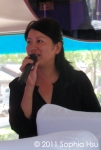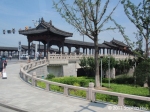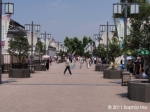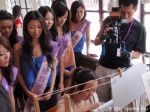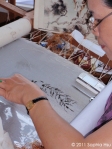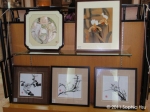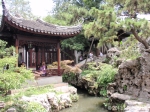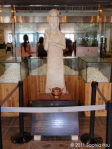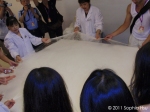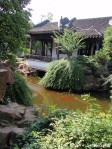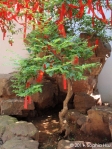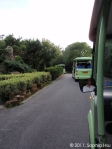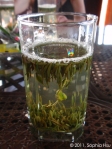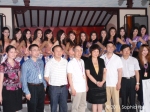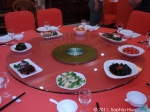Saturday, July 2, 2011
As we say goodbye to our brief affair with Shanghai, we travel an hour and a half by bus to Suzhou, the land of fish, soft, chewy rice, and silk embroidery. Suzhou is built on a network of canals much like Italy’s Venice and has long history to rival that of the Venetians. The first stop of the tour of Suzhou is a visit to the Embroidery Institute founded in 1957. One of the many early beliefs of Suzhou families was if a daughter could not embroider well, than the family would never be able to marry her off. The current student body is comprised of 150 students; most of which are female. The greatest works at the institute can be attributed to the natural beauty that surrounds Suzhou with the sweeping mountains, the network of canals, and the abundance of greenery inspiring the students.
Three styles of embroidery have been developed over a thousand years of history rooted in Suzhou. There is a the single-sided, which is pretty self-explanatory, where the image is only depicted on one side of the textile. The double-sided illustration has the exact same image on both sides of the textile, allowing onlookers to enjoy both sides. The double-sided with three differences is the most challenging where the embroiderer must skillfully stitch two completely different images on each side of the textile. The three differences that distinguish this method of embroidery are the difference in patterns between the two sides the difference in stitches on each side, and the colors used on each side must be different. The contestants marveled at the precision and skill of the students as well as admired the pieces in the shop. Entire mountain and water brush paintings interpreted perfectly by needle and thread is no small feat. Several pieces at first glance seemed to be normal Chinese calligraphy of poems and the like, but at closer observation, you can just barely make out that each individual thread isn’t actually the bleed of the ink from a brush pen but the painstakingly detailed work of a true master.
The girls were treated like true celebrities. We picked up government officials at every stop on the Suzhou tour. Each venue provided security to grant the girls VIP access as well as us, staffers. Onlookers were compelled to ask about the girls and try to take their pictures. Even our tour guide’s colleagues have requested that she take photos of this specific tour group because their office normally gets the happily retired couples time on their hands. They envy her so. I was amazed at just how much star treatment the girls received. I was lucky that they provided our badges early this morning because otherwise, I would have been cast aside completely by security. They were surprisingly efficient, and the onlookers respected our group’s space most of the time.
The Suzhou Museum was a whirlwind rush through the collections, specially guided by the museum’s curator. The most notable feature of this museum is the unique architecture reflective of the Chinese culture of black and white, the positive and negative reflected in the national animal, the giant panda, the mountain water paintings, and even, some believe, in the black irises and white eyes of the Chinese people. From the museum, we moved onto Suzhou’s lead export, silk. The silk factory we toured included a level of demonstrations, a level of shopping, and an entire level of restaurant. We were mesmerized by the collection of silk thread from the cocoons of the silk worms. In one part of the factory, we got to help a couple of workers pull the loosened cocoon into a layer in the stuffing of a comforter. It was unbelievable how strong and thin the layers were that we pulled. The lunch provided was about the same as the other prepared menus, but this is to be expected.
On the hottest day of the year so far in Suzhou reaching 38°C (100.4°F) and feeling far warmer because of the heavily humid environment, we made our way in the shade through the old town. Much like we Americans walk through Colonial Williamsburg to see how things were in different time, we ambled through the old village visiting the Humble Administrator’s Garden which was anything but humble. In the olden days of Suzhou, to be able to afford rocks dredged from the bottom of the lake by manual laborers was a status symbol. The more or bigger rocks you had was a sign of the money you made. Some of these one family homes seemed to be able to house at least a couple of families, but the belief that one should be able to enjoy the sun and water in your own home was very prevalent, so gardens were large, and front doors were small.
I got a few moments to chat with the founder of the Miss NY Chinese Beauty Pageant, William Yip, during our stroll through the old houses. With all of the work, sweat, and tears that go into preparing the contestants, training the contestants, and watching them move onto bigger and better things, why put forth the effort? For him, the farther the girls grow up away from China, the farther they grow away from the culture and the history. Hopefully, by holding this pageant, he and the very involved members of his board can prove to the contestants that beauty isn’t the only thing they have going for them, that it’s their Chinese culture that unites them and the talent and skills that they learn over the course of the pageant stay with them for a lifetime. Beauty can’t be the only thing.
Our day in Suzhou ended with a lavish banquet in the mountains overlooking Taihu Lake. First, we had tea at the summit, and a bit of Q&A time with local officials. One question that stuck with me is that the girls were asked whether or not they would be willing to stay and work for the tourism bureau seeing as they excelled in both Mandarin and English, almost all of the girls raised their hands. All of the contestants have such diverse backgrounds, I wasn’t expecting such a uniform answer. I guess this trip has already made quite an impression on the contestants.
The lavish dinner included all of the local specialties. I do mean all because there were nearly 20 dishes in total counting the appetizers, dessert, and fruit courses. In between entrees being served, I had the opportunity to get to know some of the contestants a little better. For Contestant # 10, Allison Ye, she joined the competition because she had spent much of her life just being American. It was in college at Syracuse University where she found that she could speak Cantonese with her peers. She began to discover the rich culture and history through finding her mother tongue. This sparked her quest to find out more. With her interest piqued and her friends and family suggesting that she tryout for the pageant, she now has the opportunity to find out more about her part in this rich civilization that calls itself the nation at the center of everything.
For Ji Ke “Ke Ke” Sun, Contestant # 13, she started out as a famous ping pong player, a very stereotypically Chinese endeavor. However, she realized that becoming a professional ping pong player wasn’t what she wanted out of life, so she switched gears and is now taking all the right steps to becoming an international superstar. Being a College of William and Mary alumna, I have a direct connection to Contestant # 6, Miriam Lau, as the Tribe’s green and gold are near and dear to her, too. After a few more questions, we both lived in Richmond, Virginia, and had far more things in common than this writer ever thought she would with a beauty pageant contestant like our penchant for seeking out Wawa’s during road trips. As we continued to see dishes come out of the kitchen, I learn that many of the ladies at my table have discerning palettes when it comes to traditional Chinese cuisines. Contestant # 12, Meng Di Wu, is quite the cook at home and takes a lot of pride in her cheesecakes as well. Mei Shao, Contestant # 11, grew up in the kitchen cooking for herself and her family. For Jasmine Hayter, Contestant #14, growing up with a Taiwanese mother (learning zhu ing fu hao and traditional characters) seems to have influenced her love of sweet red beans. This fully realized half British, but really, all Taiwanese girl knows what she likes.
There is so much more to learn about my travel companions and the pageant coordinators. Good thing we will be together through July 14th discovering China together.
Until tomorrow!




